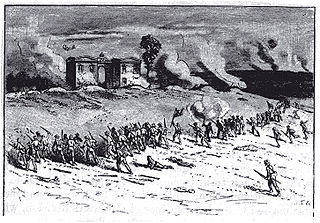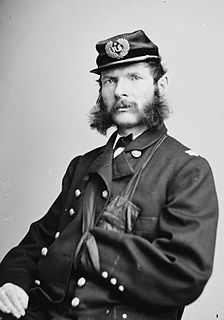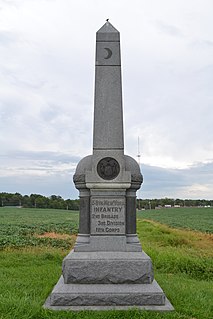Related Research Articles

Cemetery Hill is a landform on the Gettysburg Battlefield that was the scene of fighting each day of the Battle of Gettysburg. The northernmost part of the Army of the Potomac defensive "fish-hook" line, the hill is gently sloped and provided a site for American Civil War artillery.

The 1st Minnesota Infantry Regiment was the very first group of volunteers the Union received in response to the South's assault of Fort Sumter at the beginning of the United States Civil War. Minnesota's Governor Alexander Ramsey offered 1000 men to Lincoln immediately upon learning of the attack on the fort. He just happened to be in Washington when the news broke. Those men volunteered for a five-year commitment (1861–64) which was much longer than other states. During combat actions, the 1st Minnesota sustained substantial casualties at the battles of First Bull Run (20%) and Antietam (28%) and a staggering 82% at the Battle of Gettysburg, where the regiment's most famous actions occurred on the second day of the battle.
The 8th Ohio Infantry Regiment was an infantry regiment in the Union Army during the American Civil War. It served in the Eastern Theater in a number of campaigns and battles, but perhaps is most noted for its actions in helping repulse Pickett's Charge during the Battle of Gettysburg.

The Pennsylvania Reserves were an infantry division in the Union Army during the American Civil War. Noted for its famous commanders and high casualties, it served in the Eastern Theater, and fought in many important battles, including Antietam and Gettysburg.
The 14th Indiana Infantry Regiment, later referred to as the Gallant Fourteenth, was an infantry regiment and part of the Union Army's celebrated "Gibraltar Brigade" of the Army of the Potomac during the American Civil War. Organized in May 1861 at Camp Vigo, near Terre Haute, Indiana, it was the state's first regiment organized for three years of service. The 14th Indiana served in major campaigns and battles in the Eastern Theater, mostly in West Virginia, Virginia, Pennsylvania, and Maryland. During its three years of service, the regiment had a total of 222 casualties.
The Philadelphia Brigade was a Union Army brigade that served in the American Civil War. It was raised primarily in the city of Philadelphia, Pennsylvania, with the exception of the 106th regiment which contained men from Lycoming and Bradford counties.
The 4th Ohio Infantry Regiment was an infantry regiment in the Union Army during the American Civil War. It served in the Eastern Theater in a number of campaigns and battles, but perhaps is most noted for its actions in helping secure Cemetery Hill during the Battle of Gettysburg.
The 7th West Virginia Infantry Regiment was an infantry regiment that served in the Union Army during the American Civil War. For much of the war, it was a part of the famed "Gibraltar Brigade" in the Army of the Potomac. It was famed primarily for two major actions, a determined charge on the Sunken Road at Antietam and a late evening counterattack on East Cemetery Hill at Gettysburg that helped push back an attack by the Louisiana Tigers.
The 19th Regiment Indiana Volunteer Infantry was an infantry regiment that served in the Union Army during the American Civil War. It was one of the original regiments in the Army of the Potomac's Iron Brigade.

The 7th Ohio Infantry Regiment was an infantry regiment formed in northeastern Ohio for service in the Union Army during the American Civil War. It served in the Eastern Theater in a number of campaigns and battles with the Army of Virginia and the Army of the Potomac, and was then transferred to the Western Theater, where it joined the Army of the Cumberland besieged at Chattanooga. It is of the 7th regiment that a war historian wrote, "All in all, considering the number of its battles, its marches, its losses, its conduct in action, it may be safely said that not a single regiment in the United States gained more lasting honor or deserved better of its country than the Seventh Ohio Volunteer Infantry."

William J. Colvill Jr. was an American Union colonel in the American Civil War who led the 1st Minnesota Volunteer Infantry in the Battle of Gettysburg. He was Minnesota Attorney General from 1866 to 1868 and he also served in the Minnesota House of Representatives.

Samuel Sprigg "Red" Carroll was a career officer in the United States Army who rose to the rank of brigadier general during the American Civil War. The Maryland native was most known for his service as the commander of the famed "Gibraltar Brigade," an infantry brigade in the Army of the Potomac that played a key role during the defense of Cemetery Hill during the Battle of Gettysburg, as well as in repulsing a portion of Pickett's Charge.
The 16th Maine Infantry Regiment was an infantry regiment that served in the Union Army during the American Civil War. It was particularly noted for its service during the 1863 Battle of Gettysburg.

Erastus Bernard Tyler was an American businessman, merchant, and soldier. He was a general in the Union Army during the American Civil War and fought in many of the early battles in the Eastern Theater before being assigned command of the defenses of Baltimore, Maryland. He briefly commanded the VIII Corps.

The Iron Brigade, also known as The Black Hats, Black Hat Brigade, Iron Brigade of the West, and originally King's Wisconsin Brigade was an infantry brigade in the Union Army of the Potomac during the American Civil War. Although it fought entirely in the Eastern Theater, it was composed of regiments from three Western states that are now within the region of the Midwest. Noted for its strong discipline, its unique uniform appearance and its tenacious fighting ability, the Iron Brigade suffered the highest percentage of casualties of any brigade in the war.

Charles Candy was a career soldier in the United States Army who served as an officer in the volunteer Union Army during the American Civil War. He commanded an Ohio regiment and, frequently, a brigade, during the war, and played a role in the defense of Culp's Hill during the July 1863 Battle of Gettysburg.

Robert Bruce Ricketts distinguished himself as an artillery officer in the American Civil War. He is best known for his battery's defense against a Confederate attack on Cemetery Hill on the second day of the Battle of Gettysburg on July 2, 1863.
The 1st Maryland Infantry Regiment, Potomac Home Brigade was an infantry regiment that served in the Union Army during the American Civil War.

The battle of East Cemetery Hill during the American Civil War was a military engagement on the second day of the Battle of Gettysburg, in which an attack of the Confederacy's Louisiana Tigers Brigade and a brigade led by Colonel Robert Hoke was repelled by the forces of Colonel Andrew L. Harris and Colonel Leopold von Gilsa of the XI Corps, plus reinforcements. The site is on Cemetery Hill's east-northeast slope, east of the summit of the Baltimore Pike.

The 58th New York Infantry Regiment, also called the Polish Legion, was an infantry regiment of United States Volunteers in Union Army service during the American Civil War. The regiment was composed almost entirely of immigrant volunteers: Poles, Germans, Danes, Italians, Russians, and Frenchmen, most of whom were recruited at New York City in 1861.
References
- Dyer, Frederick Henry, A Compendium of the War of the Rebellion. 3 volumes. New York: T. Yoseloff, 1908.